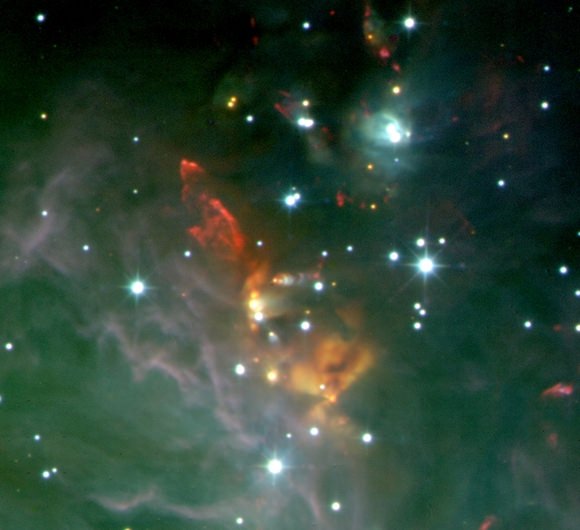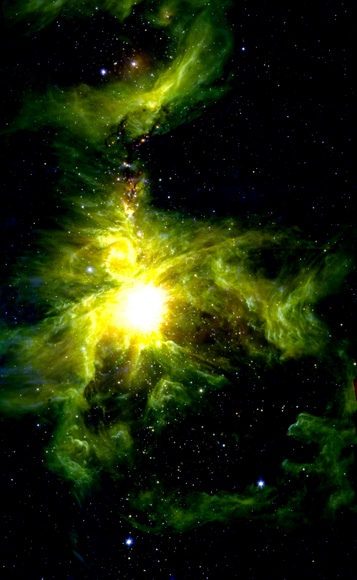Using infrared telescopes, European and American astronomers have peered through the opaque molecular cloud that obscures much of Orion’s stellar nursery from view.
They’ve discovered a rowdy scene there — a crowded stellar nursery, with young stars shooting supersonic hydrogen jets in all directions — and they’re reporting there is much more going on in Orion than previously thought.
The new survey is the most wide-ranging census ever produced of dynamical star formation in and around the well-known Great Nebula of Orion.
In the United Kingdom Infrared Telescope/Spitzer Space Telescope image above, parts of the Orion Molecular cloud are illuminated by nearby stars and glowing an eerie green. The jets punch through the cloud and can be seen as tiny pink-purple arcs, knots and filaments. The golden orange young stars that drive the jets can usually be seen nearby.
Below, a gas jet (seen in red) pops out of a busy region of star formation in Orion. All the red wisps, knots and filaments are in fact associated with jets from young stars, which in this figure are colored orange. The data were acquired with the Wide Field Camera at the United Kingdom Infrared Telescope. (Story continues beneath image.)

The Orion Molecular Cloud is more than 20 times the angular size of the full moon, spanning from far above the hunter’s head to far below his feet. Most of the action is hidden from view in visible light. Earthbound stargazers can see he brightest stars, like Betelgeuse and Rigel at the shoulder and knee of the constellation, and perhaps the Orion Nebula as a vaguely fuzzy patch around the sword. The nebula, which is really just a blister on the surface of the cloud, gives the only indication of the chaos within.
The team studied the region with the United Kingdom Infrared Telescope (UKIRT) on Mauna Kea, the Spitzer Space Telescope, which works at even longer “mid-infrared” wavelengths, and the IRAM Millimeter-wave (radio) Telescope in Spain.
The power of the census came from the combination of data from all three facilities, the researchers say. Inspired by the richness of his images from UKIRT, Chris Davis, of Hawaii’s Joint Astronomy Centre, contacted colleagues in Europe and on the United States mainland.
Tom Megeath, an astronomer from the University of Toledo, provided a catalogue of the positions of the very youngest stars – sources revealed only recently by the Spitzer Space Telescope.
Thomas Stanke, a researcher based at the European Southern Observatory in Garching, Germany, then provided extensive IRAM maps of the molecular gas and dust across the Orion cloud.
Dirk Froebrich, a lecturer at the University of Kent, later used archival images from the Calar Alto Observatory in Spain (data acquired by Stanke some 10 years ago) to measure the speeds and directions of a large number of jets by comparing them with their positions in the new images.
Armed with these data, Davis was able to match the jets up to the young stars that drive them, as well as to density peaks within the cloud – the natal cores from which each star is being created.
“Regions like this are usually referred to as stellar nurseries, but we have shown that this one is not being well run: it is chaotic and seriously overcrowded,” Davis said. “Using UKIRT’s wide field camera, we now know of more than 110 individual jets from this one region of the Milky Way. Each jet is traveling at tens or even hundreds of miles per second; the jets extend across many trillions of miles of interstellar space. Even so, we have been able to pinpoint the young stars that drive most of them.”
Andy Adamson, associate director at the UKIRT, added that the dataset “demonstrates the power of survey telescopes like UKIRT. With on-line access to data from other telescopes around the world, and the ease with which one can communicate with collaborators across the globe, massive projects like the Orion study are very much the future of astronomy.”
Several of the researchers are presenting their discoveries with colleagues at this year’s annual National Astronomy Meeting of the UK (NAM 2009).
Source: Joint Astronomy Centre. For more information, visit
The UK Infrared Telescope
The Spitzer Space Telescope
The IRAM Millimeter-wave Telescope
NAM 2009
Royal Astronomical Society


Great work. It’s inspiring to note that such a well-studied area such as the Orion complex still gives up new secrets almost as often as scopes are turned towards it. I think in astronomy, it’s almost always a safe bet to assume that there is a lot more going on than meets the eye initially, or indeed, even after years of study.
OK, here’s probably a dumb question, but…
What does “supersonic” mean in this context? I’m referring specifically to the sentence “a crowded stellar nursery, with young stars shooting supersonic hydrogen jets in all directions”.
Since the gas jet from the star is being blasted into a gas ( the gas/dust of the nebula that the star resides in ), and the speed of the gas jet is faster than the speed of sound in the gas, the jet is supersonic. Note that the speed of sound through the gas will be vastly different than the speed of sound in air at atmospheric pressure, but either way, the sheer speed of the jet would be many times faster than the ‘sonic speed’ of the gas.
“# Jorge Says:
April 19th, 2009 at 4:36 pm
“OK, here’s probably a dumb question, but…
What does “supersonic” mean in this context? I’m referring specifically to the sentence “a crowded stellar nursery, with young stars shooting supersonic hydrogen jets in all directions”.”
Not a dumb question. As Joe mentioned, the stars are embedded in a tenuous, gaseous nebula. For any gas, a speed of sound can be defined – it’s just the speed at which pressure waves are transmitted through it. This holds true even for very very tenuous gasses such as the interstellar or even intergalactic medium. Certainly in a region of higher than average density such as the Orion Nebula… Anyway – that’s not to say if you found yourself floating along out there you could actually hear something – the gas is far too tenuous to exert sufficient pressure variations to cause your ear to register a sound. The density of gas in most parts of such regions is far less than even the best laboratory vacuums here on Earth. But the gas exists and sound waves can propagate through it none-the-less.
So in this case, the jets are being expelled from the proto-stars at a higher speed than the speed of sound in that region. Hence the jets are supersonic.
Allright. Makes perfect sense. Or would, except…
Isn’t that kind of a given? Aren’t those jets supposed to be shot at extremely high speeds, vastly superior to any kind of compression waves in gases, however thin they may be?
If they are, why bother with that word?
I suppose the word may be a tad redundant, but I guess it is worth specifying because the fact that the jets are supersonic substantially alters the physics involved in the creation/propagation of shock fronts, etc.
Great work!!!
What a nice surprise to see my old astronomy prof, Tom Megeath in the middle of the study! 🙂
Go Rockets
The use of the term “supersonic” may be considered slightly redundant, but it made me think… :
The speed of sound in a gas under “normal” conditions varies with temperature and molecular weight, and also with the elasticity (i.e. how the gas stores energy while being compressed)…
…but not much, if at all, with pressure. I wonder, does this still hold true under such extreme conditions – like in an atmosphere, where the pressure is much like what would probably be considered a “pretty good vacuum” in a laboratory experiment?
“…but not much, if at all, with pressure. I wonder, does this still hold true under such extreme conditions – like in an atmosphere, where the pressure is much like what would probably be considered a “pretty good vacuum” in a laboratory experiment?”
There is certainly a point where the physics changes when the mean free path of molecules becomes very large. In lab scenarios this is called the transition to ‘free molecular flow’. I’m not sure precisely what effect this has. It is an interesting question though…